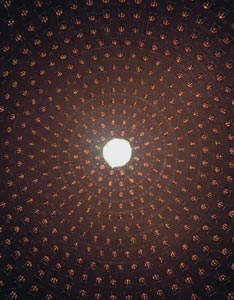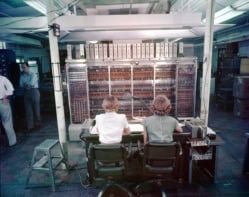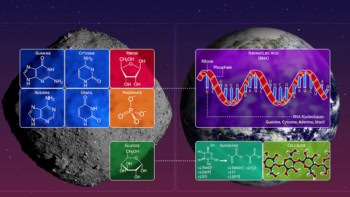With the 2019 Nobel Prize for Physics due to be announced on Tuesday 8 October, Physics World journalists pick their favourite Nobel awards from the past. Here Tushna Commissariat argues the case for the 2015 prize for the discovery of neutrino oscillations, which shows that neutrinos have mass

I’ve always been fascinated by neutrinos, those tricksy fundamental particles that abound the universe ( you’ve probably heard it before, but some 65 billion neutrinos pass through a space as small as your fingernail every second) but are rather hard to detect, as they are electrically neutral, and only interact with matter via gravity and the weak force. First predicted 89 years ago by Wolfgang Pauli as a “desperate remedy” for discrepancies arising in the study of beta decays, these so-called ghostly particles were thought to be impossible to detect. In fact, Pauli himself famously bet a case of champagne that it could never be done, supposedly saying “I have done a terrible thing, I have postulated a particle that cannot be detected .”
Pauli was happily proven wrong though, when Frederick Reines and Clyde Cowan detected antineutrinos emitted by a nuclear reactor, in 1956 – a feat that earned Reines the 1995 Nobel Prize for Physics. Indeed, neutrino astronomy is a rather Nobel-friendly topic, with the 1988 prize awarded jointly to Leon M Lederman, Melvin Schwartz and Jack Steinberger “for the neutrino beam method and the demonstration of the doublet structure of the leptons through the discovery of the muon neutrino“, as well as the 2002 prize, one half of which was awarded to Raymond Davis Jr and Masatoshi Koshiba “for pioneering contributions to astrophysics, in particular for the detection of cosmic neutrinos“.

Neutrinos: ghosts of matter
But the neutrino Nobel that fascinates me the most is the 2015 prize, given to to Arthur B McDonald and Takaaki Kajita “for the discovery of neutrino oscillations, which shows that neutrinos have mass”. You see, early theories suggested that neutrinos were massless particles. But by 1957, Italian physicist Bruno Pontecorvo was already considering the possibility that multiple types, or “flavours” – electron, muon and tau – of neutrinos exist, and that they can change, or “oscillate”, from one to another. This was confirmed by 1962, when Lederman, Schwartz and Steinberger observed the existence of the electron and muon neutrino at Brookhaven National Laboratory in the US , while the tau neutrino was ultimately discovered in 2000.
But a rather chilling conundrum soon raised its head, in the form of the “solar neutrino problem”, when an experiment at the Homestake Gold Mine in South Dakota, carried out by physicists Raymond Davis and John Bahcall, detected only about 30% of the amount of solar neutrinos that it should have, as predicted from the Sun’s luminosity. The only way to explain this discrepancy (short of worrying that the Sun itself was dying, which was considered for a while) was that the solar neutrinos were oscillating between flavours, as they travel from the Sun to the Earth. The Homestake experiment (which could only detect electron neutrinos), was therefore only picking up a third of the actual amount. A direct consequence of this solution was that neutrinos must possess mass, for these oscillations to take place – but this was contrary to the Standard Model of particle physics prediction of them being massless particles.
This is one of the reasons why I find neutrinos so interesting – while not being able to explain some pretty major phenomena such as gravity, dark matter and energy, and the matter–antimatter asymmetry, the Standard Model is one of the most successful and pervasive theories of particle physics to date, one that has consistently been proven to be accurate. To find out then, that neutrino physics is beyond the ken of the Standard Model, must have been a rather exciting prospect for physicists. But the proof of these neutrino oscillations, and therefore their mass, was a long time coming, and was what won Kajita and McDonald their Nobel in 2015. Kajita and his colleagues were part of the Japanese Super-Kamiokande experiment, which in 1998 showed that the ratio of electron to muon neutrinos coming from opposite sides of the Earth were different, showing that neutrinos changed flavour as they travelled long distances and passed through the Earth. For the first time, physicists were able to experimentally show that neutrinos must have mass, albeit only about 0.1 eV. A year later, the Sudbury Neutrino Observatory (SNO), led by McDonald, began collecting data, and was able to determine how many of the electron neutrinos produced in the Sun change into muon neutrinos or tau neutrinos as they travel to the Earth. SNO data were able to confirm the fact that about two-thirds of the solar electron neutrinos change flavour by the time they reach the Earth.

Triumphs and frustrations
While neutrino science has significantly advanced in the years since both those experiments, there are still many questions, including the fact that we still don’t know what the exact masses of the three neutrino flavours, or how they achieve this mass. The day after the 2015 prize, I wrote a blog about why improving our understanding of neutrino mass is so important, when it comes to some of the big unanswered question in physics today. Enticingly, the answer to one or even more of those Standard Model problems that I previously mentioned may lie with an as-yet-undiscovered, but long coveted, fourth type of neutrino dubbed the sterile neutrino … but you’ll simply have to read that blog to find out more. I do hope, though, that I have made a good case for why neutrino Nobel prizes have fascinated me so. In any case, I will leave you with the captivating words of physicist Frederick Reines who once described neutrinos as “the most tiny quantity of reality ever imagined by a human being”.
Physics World‘s Nobel prize coverage is supported by Oxford Instruments Nanoscience, a leading supplier of research tools for the development of quantum technologies, advanced materials and nanoscale devices. Visit nanoscience.oxinst.com to find out more.




